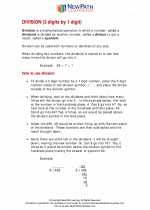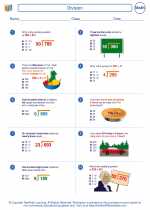Order of Operations
Order of operations refers to the rules that determine the sequence in which mathematical expressions should be evaluated. The order of operations is important as it ensures that everyone will get the same result when evaluating a given expression.
The Order of Operations Rules
- Parentheses: Evaluate expressions inside parentheses first.
- Exponents: Perform any calculations involving exponents (powers and roots).
- Multiplication and Division: Perform multiplication and division from left to right.
- Addition and Subtraction: Perform addition and subtraction from left to right.
One way to remember the order of operations is to use the acronym PEMDAS:
- P - Parentheses
- E - Exponents
- M - Multiplication
- D - Division
- A - Addition
- S - Subtraction
Example:
Let's solve the following expression using the order of operations: 5 + 3 * (7 - 2)
- First, we evaluate the expression inside the parentheses: 7 - 2 = 5
- Then, we multiply 3 by the result from step 1: 3 * 5 = 15
- Finally, we add 5 and the result from step 2: 5 + 15 = 20
Study Guide:
To master the order of operations, it's important to practice with various expressions. Here are some tips for studying this topic:
- Practice solving expressions using the order of operations.
- Challenge yourself with expressions that involve multiple operations.
- Use the PEMDAS acronym as a guide when solving expressions.
- Check your work by following the order of operations step by step.
- Seek additional help or explanations if you encounter difficulties.
Remember, understanding the order of operations is crucial for solving mathematical expressions accurately. With practice and perseverance, you can become proficient in applying these rules.
[Order Of Operations] Related Worksheets and Study Guides:
.◂Math Worksheets and Study Guides Sixth Grade. Division
Study Guide Division
Division  Worksheet/Answer key
Worksheet/Answer key Division
Division  Worksheet/Answer key
Worksheet/Answer key Division
Division  Worksheet/Answer key
Worksheet/Answer key Division
Division 

 Worksheet/Answer key
Worksheet/Answer key
 Worksheet/Answer key
Worksheet/Answer key
 Worksheet/Answer key
Worksheet/Answer key

The resources above cover the following skills:
Connections to the Grade 6 Focal Points (NCTM)
Number and Operations: Students' work in dividing fractions shows them that they can express the result of dividing two whole numbers as a fraction (viewed as parts of a whole). Students then extend their work in grade 5 with division of whole numbers to give mixed number and decimal solutions to division problems with whole numbers. They recognize that ratio tables not only derive from rows in the multiplication table but also connect with equivalent fractions. Students distinguish multiplicative comparisons from additive comparisons.